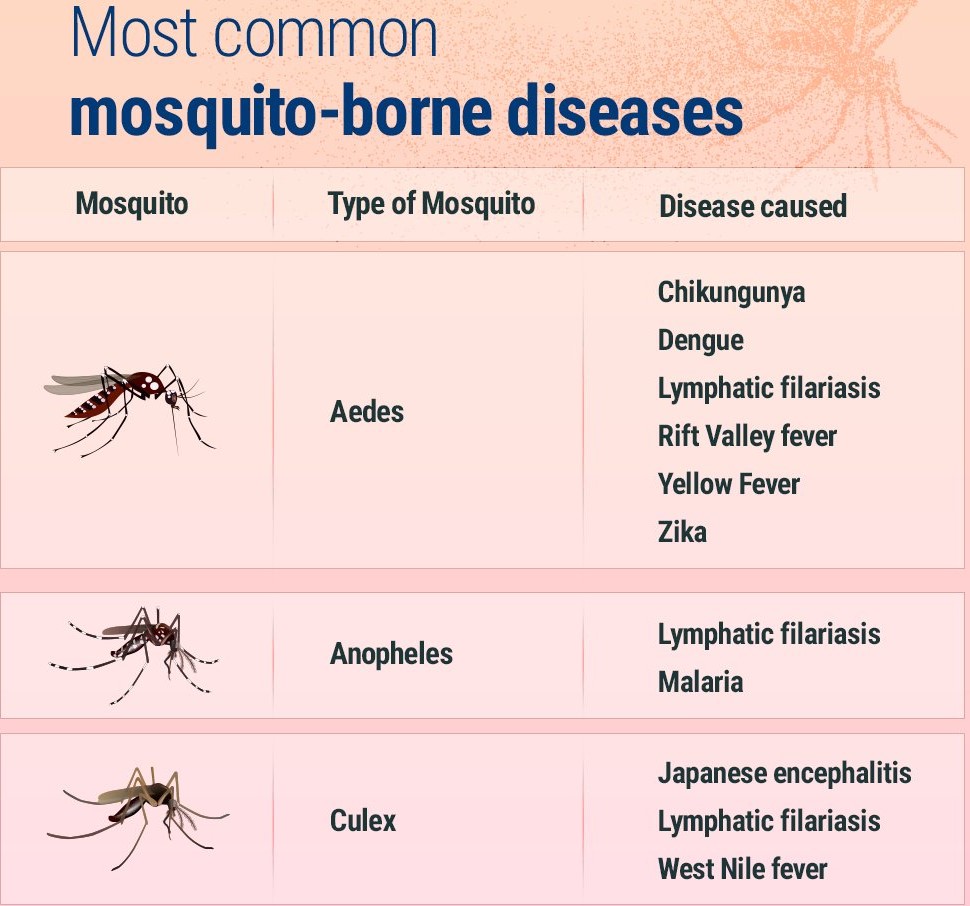Syllabus: GS-II: Health.
Why in News
Mosquito-borne diseases have emerged as a persistent public health challenge in India, with new evidence showing mosquito breeding expanding to hill areas due to climate change. According to Dr. Rajni Kant, Chair, Indian Council of Medical Research (ICMR), the increasing spread of malaria, dengue, and Japanese encephalitis (JE) in previously unaffected high-altitude regions like Darjeeling marks a worrying trend.
He also warned against the indiscriminate use of mosquito repellents, citing health risks from long-term exposure, and called for multi-sectoral collaboration between health, municipal, and environmental agencies to address the crisis comprehensively.
Mosquito-Borne Diseases in India
| Disease | Causative Agent | Vector | Key Affected States | Remarks |
| Malaria | Plasmodium spp. (vivax, falciparum) | Anopheles mosquito | Odisha, Chhattisgarh, Jharkhand, MP, NE States | National Framework for Malaria Elimination (NFME) by 2030 |
| Dengue | Dengue virus (Flavivirus) | Aedes aegypti | Delhi, Assam, Maharashtra, Tamil Nadu | Increasing urban outbreaks |
| Chikungunya | Alphavirus | Aedes aegypti | Karnataka, Maharashtra | Causes severe joint pain |
| Japanese Encephalitis (JE) | Flavivirus | Culex tritaeniorhynchus | Assam, UP, Bihar | Vaccine available |
| Zika Virus | Flavivirus | Aedes aegypti | Kerala, Gujarat, Maharashtra | Sporadic outbreaks since 2017 |
Current Status in India
- Dengue: India reported over 2.7 lakh dengue cases and 90+ deaths in 2023 (NVBDCP data).
- Rising cases in hill districts of West Bengal, Himachal Pradesh, and Uttarakhand indicate climate-linked vector expansion.
- Malaria: India contributes ~1.6% of global malaria cases and aims for elimination by 2030 under the National Framework for Malaria Elimination (NFME).
- Despite a decline of over 85% in malaria cases between 2015–2022, new hotspots are emerging in North East and hilly states.
- Japanese Encephalitis: Endemic in Assam, Bihar, and UP, JE outbreaks are often seasonal (monsoon-linked). India runs a Universal Immunisation Programme (UIP) for JE vaccines in endemic areas.
Why Mosquito-Borne Diseases Are Rising
- Climate Change: Warmer temperatures and erratic rainfall expand mosquito habitats into hill regions.
- Urbanisation: Poor drainage, stagnant water, and waste accumulation create ideal breeding grounds.
- Insecticide Resistance: Mosquitoes have developed resistance to traditional repellents and insecticides.
- Unplanned Water Storage: Increased dependence on water storage in rural and urban homes facilitates Aedes breeding.
- High Mobility: Increased travel spreads diseases to new geographies.
- Long-term Use of Chemical Repellents: Continuous exposure poses health risks and reduces effectiveness over time.
Methods Adopted to Control Mosquitoes in India
1. Chemical and Mechanical Control
- Fumigation & Fogging: Commonly used by municipal bodies; helps kill adult mosquitoes but ineffective for larvae.
- Larvicidal Measures: Spraying temephos or Bacillus thuringiensis israelensis (BTI) to kill larvae in stagnant water.
- Use of Repellents: Creams, coils, and vaporizers, though prolonged use can cause respiratory and neurological side effects.
2. Biological Control (Wolbachia Method)
- Wolbachia bacteria, introduced into Aedes aegypti, prevent mosquitoes from transmitting viruses.
- Trials in Malaysia, Indonesia, and India (Bengaluru) show promising results with up to 70% reduction in dengue transmission.
3. Environmental Management
- Elimination of breeding sites: Covering drains, ensuring no stagnant water in containers.
- Source reduction: Cleaning irrigation canals, storm drains, and domestic tanks regularly.
- Urban planning: Improved waste management and drainage infrastructure.
4. Vaccination and Medical Interventions
- JE Vaccine: Available under the Universal Immunisation Programme (UIP).
- Dengue Vaccine (Dengvaxia): Approved in select countries, under trial evaluation in India.
- New antimalarial drugs and ACT (Artemisinin-based Combination Therapy) being deployed for malaria elimination.
Why Current Measures Are Failing
- Fragmented Institutional Response: Coordination gaps between Health, Urban Development, and Rural Departments.
- Reactive Approach: Focus on fogging during outbreaks, not preventive source reduction.
- Limited Community Participation: Public awareness on mosquito breeding remains low.
- Vector Resistance: Increasing resilience to insecticides and genetic adaptability.
- Poor Urban Drainage Systems: Especially in metros and flood-prone states.
- Overreliance on Repellents: Causes chemical resistance and health concerns.
Potential and Opportunities
- Integrated Vector Management (IVM): Combining biological, environmental, and community measures.
- AI & GIS Surveillance: Use of real-time mapping, predictive analytics, and drones to monitor vector hotspots.
- Research and Innovation: Indigenous production of biopesticides, gene drive technologies, and climate-resilient mosquito control models.
- Community Health Workers (ASHA, ANM): Can act as grassroot vector-control champions.
Way Forward
- Strengthen Integrated Vector Management (IVM): Multi-sectoral coordination involving health, municipal, and environmental departments.
- Promote Eco-Friendly Methods: Scale up Wolbachia and biological larvicide trials across urban and rural zones.
- Invest in R&D: Support for indigenous vaccine development and AI-based early warning systems.
- Public Health Education: Community participation in eliminating breeding sites must be institutionalized.
- Climate-Sensitive Planning: Include vector control in climate adaptation policies for hill and forest regions.
- Strengthen Surveillance: Integrated Disease Surveillance Programme (IDSP) should include real-time vector mapping.
Conclusion
Mosquito-borne diseases continue to pose a multi-dimensional challenge to India’s public health framework. The expansion of vectors to hilly regions underscores the climate-linked evolution of disease ecology. Combating this requires not only medical interventions but also ecological sensitivity, community action, and interdepartmental coordination. As India moves towards its Malaria Elimination Target (2030), the success of this mission will depend on integrating innovation with local action to make the fight sustainable and inclusive.
Mains Practice Question
“With changing climatic patterns, mosquito-borne diseases are spreading beyond traditional zones in India. Discuss the major challenges in controlling such diseases and suggest an integrated strategy for their elimination by 2030.”
(250 words)
Start Yours at Ajmal IAS – with Mentorship StrategyDisciplineClarityResults that Drives Success
Your dream deserves this moment — begin it here.






